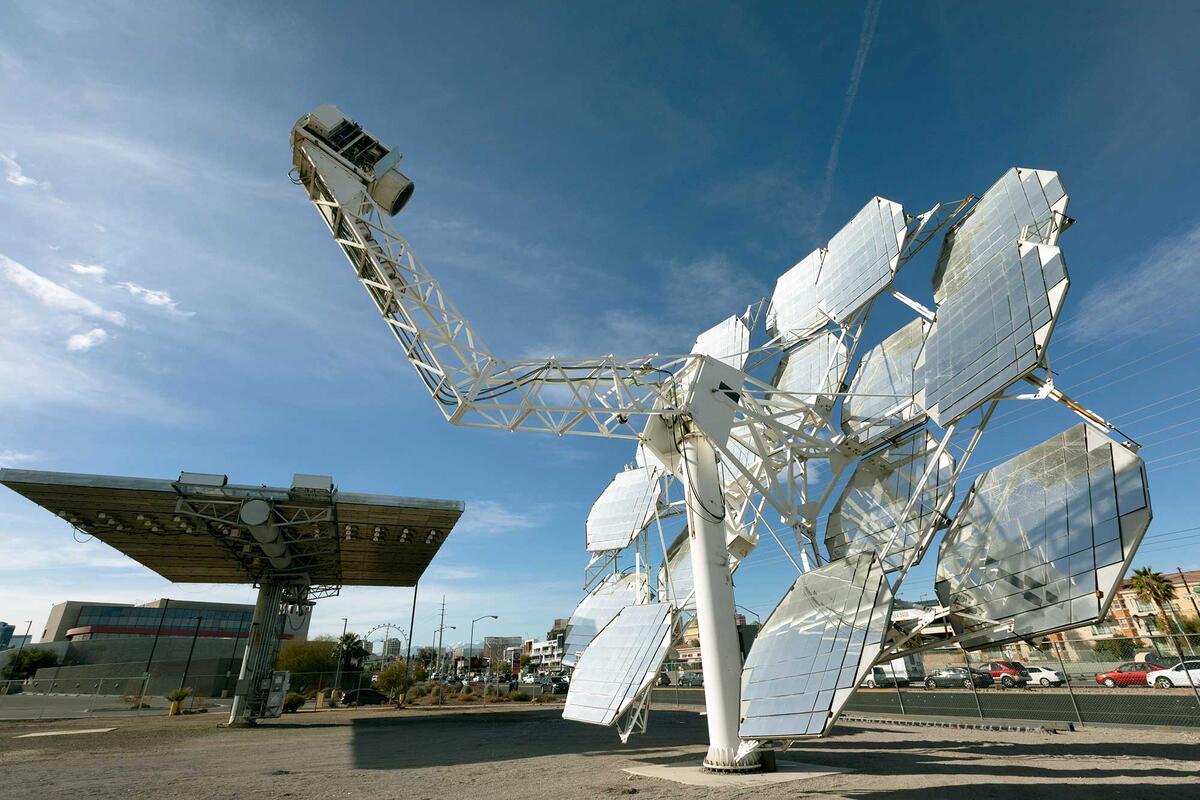
Energy and Water Management
As a responsible community member, UNLV is committed to the efficient use of water and energy resources in support of our educational and research mission.
Water Consumption
UNLV is working with the Southern Nevada Water Authority to research, pilot, and implement various water-smart technologies.
Landscape Water Use
During the past two decades, UNLV replaced more than 1.3 million square feet of grass with water saving desert landscape and implemented centralized irrigation controls.
Visit the Water Conservation webpage for more information.
Water Cooling Towers and Upgrades
UNLV is working with the Southern Nevada Water Authority to increase efficiency and reduce water usage at all water cooling towers.
Indoor Water Savings
Our indoor water conservation efforts include:
- Replacing urinals with those that use 0.125 gallons per flush. This saves approximately 87 gallons for every 100 flushes
- Using faucet aerators (screens that control water flow) to release 0.5 gallons of water per minute (gpm). This saves approximately 12 gallons of water per 100 uses
- Utilizing toilets that use 1.28 gallons of water per flush. This saves approximately 30 gallons of water per 100 flushes.
Visit the Southern Nevada Water Authority webpage to learn more about Southern Nevada’s water cycle.
Greenhouse Gas
The following tools are used by UNLV as part of our commitment to reduce our greenhouse gas emissions:
Electric Carts
- The electric carts on campus replaced vehicles that use diesel fuel. UNLV does a majority of moving about campus using electric carts. There are more than 600 electric carts on campus.
Electric Vehicle Charging Stations
- UNLV offers electric vehicle charging stations throughout campus. Visit the Electric vehicle charging stations webpage for more information.
Arboretum
- Eighty acres of the UNLV campus are landscaped with trees, shrubs and desert landscape and includes a two-acre xeric garden. Visit the Arboretum webpage for more information.
Refrigerants
- In compliance with the Clean Air Act, UNLV is committed to phasing out Class I and Class II ozone-depleting substances (ODS). A Class II ODS is the R-22 refrigerant, which continues to be replaced with newer equipment or other refrigerant blends that have lower global warming potential.

Electricity and Natural Gas
Prior to 2020, UNLV’s total usage for electricity and natural gas was 550,000,000 KBtu (one kilo-British thermal unit) on average.
*Btu: British thermal unit; measurement of the heat content of fuels or energy sources
Our electrical and natural gas conservation efforts include the following:
LED Lighting
- Approximately 90 percent of lights on campus are LED
- Exterior LED lights were installed in outdoor walkways, garages, and buildings.
- Interior LED lights were installed during the T8 fluorescent tube replacement project.
- 65,000 fluorescent tubes were replaced
- Many other interior fixtures including incandescent and fluorescent recessed lighting were replaced
Building Heating and Cooling
- Facilities Management operates a number of central plants that provide both chilled and hot water for our campus’ cooling and heating needs.
- Central plants efficiently cool and heat water that is used for HVAC and other processed water needs such as lab equipment. They do this much more efficiently than standalone systems within each building by centralizing and scaling this equipment.
- These plants produce 7,500 Tons of cooling and 75,000 mBH of heating
- Cooling energy use in central plants is roughly half that of typical individual air conditioning units.
- At the building level, we are also replacing inefficient package HVAC units with higher SEER (Seasonal Energy Efficiency Ratio) rated units.
Building Automation
- We use instrumentation, sensors, and other automated systems to measure temperature, humidity, air, and water flow in UNLV’s HVAC systems.
- Most buildings on campus use systems that adjust the amount of air in a given space to either cool or heat the space.
- Building Automation writes software that controls these systems to optimize our buildings efficiently while reducing our carbon footprint.
Belimo Energy Valves
- UNLV uses Belimo energy valves on every HVAC unit. They slow down water flow to get more energy out of the water.
- This makes equipment run more efficiently and prevents over-pumping. One way they accomplish this is by remotely controlling when and how each pump operates.
Retrocommissioning (RCx) Campus Central Plants
- Retrocommissioning (RCx) campus central plants is a common way to fine-tune the cooling and heating of a central plant system. This is accomplished by retrofitting existing equipment, changing controls parameters, sequencing, and setpoints.
- Once accomplished, the plant is set to operate at a peak performance and may see energy savings in the 10-20% range. As a major consumer of energy, this is a significant impact.
- As part of a new infrastructure planning initiative, UNLV looks to retro commission all major plants and energy systems.
Solar
UNLV has fifteen buildings with solar panels that have 1.4 MW of generation capacity.
- The total generation from the arrays from 2014-22 was 11,071, 518 kW-hr (kW-hr: one kilowatt of energy for one hour)
- This is equivalent to offsetting electricity use in 116 homes per year, on average.
This yield reduces approximately 1,244 metric tons of carbon dioxide emissions. This is equivalent to:
- 1.3 million pounds of coal burned
- 140,000 gallons of gasoline consumed
- 3 million miles driven by an average gas-powered vehicle
- 200 gas-powered vehicles driven for one year
- 2,000 barrels of oil consumed
This is equivalent to greenhouse gas emissions avoided by:
- 400 tons of waste recycled instead of landfilled
- 60 garbage trucks of waste recycled instead of landfilled
- 50,000 trash bags of waste recycled instead of landfilled
The university started installing the panels in 2013 as part of a subsidy through NV Energy.
